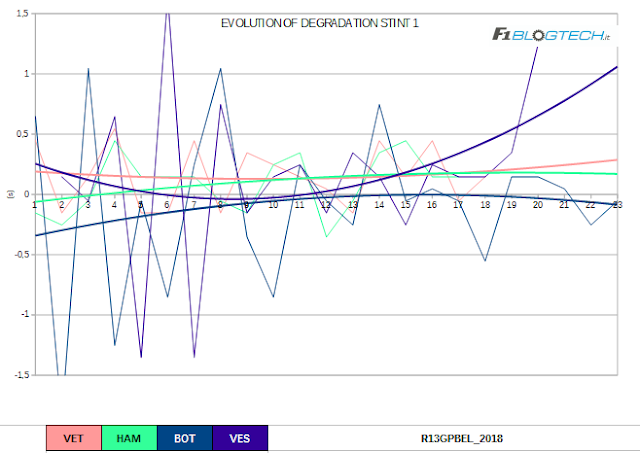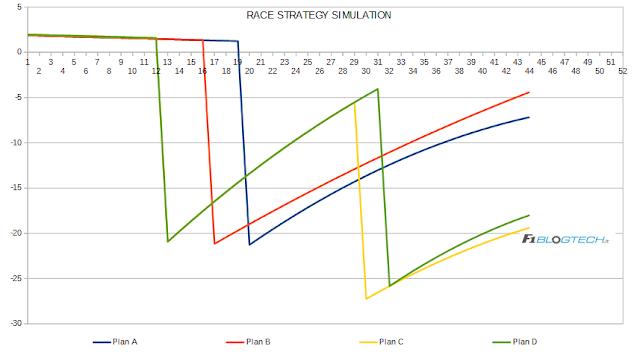THE BATTLE OF THE BULGE

FROM FRIDAY SIMULATIONS
What emerged during the Friday dedicated to the simulations was that the race would have been, once again, a single pit-stop. Starting with the SuperSoft rubber, if this had lasted long enough, the Soft rubber could have been fitted, otherwise it would have been possible to mount the Media rubber. The latter had shown to be quite competitive compared to other choices, as opposed to what happened on other tracks this year in which the harder compound was discarded.
As for the setup, it must be said that Ferrari has opted for a higher downforce aerodynamic package than the direct competitor. It is an advantage derived from the good efficiency of the SF71H and the extra Power Unit horses that arrived for this event. As for RedBull, the team had to look for the best aerodynamic compromise by having fewer horses than the other two top teams. They then brought a very low rear wing relying on the load generated by the bottom of the car.
Turning to the analysis of the race simulations, which took place at a temperature of 21°C, on the Ferrari of Kimi Raikkonen there was a bit of blistering on the rear left which who was 'cured' with changes to the setup. The problem with the blistering was smaller on the W09, which however suffered of a bad balance during the long runs.
Both teams, however, have decided to qualify and start with the SuperSoft tire. For the race there was nothing left to mak last as long as possible the SuperSoft rubber and then mount the Soft or the Medium tire.
THE RACE STRATEGY
CONDITIONS OF THE TRACK
The temperature of the track during the race has risen slightly compared to the Free Practice, going from 21°C to 29°C. The air temperature remained at 17°C. Some drivers were warned of a headwind at turn 12.
A QUICK SUMMARY OF THE RACE
Starting in second place, Vettel overtook Hamilton on the long Kemmel straight, just before the Safety Car came out due to the accident, unleashed by Hulkemberg, who then involved Alonso, Ricciardo and Leclerc.
For the RedBull was a two-sided race with Verstappen coming back to the third position and Ricciardo retired due to a contact in the initial crash.
Raikkonen was victim of a puncture in the first corner that ruined the race and after a few laps he retired.
The battle in the lead went ahead as an 'elastic' with Vettel who responded to the times of Hamilton.
Before starting, we propose a table with the race pace held by the drivers in order to make the reading smoother.
WHY RAIKKONEN MOUNTED THE MEDIUM RUBBER AFTER THE PUNCTURE RATHER THAN THE SUPERSOFT AS BOTTAS?
The main idea that led Ferrari to mount the Medium rubber to Raikkonen immediately after the incident was to try to go to the end, therefore remaining on the strategy of the only pit-stop. Bottas, instead, who started from the back, was forced to the pit on the first lap because of a damage to the front wing during a crash at the first corner.
However, Mercedes opted for the red tire. This because it could be a better tire to get rid of the traffic quickly and then hope for a Safety Car to compact the group at the lead. Choosing the Medium, a tire anyway with less performance, it might have been a bit longer to get away from the slower group, but then it would not have been necessary to stop again and Raikkonen could have gone straight to the finish line. Bottas, on the contrary, would have surely have to stop another time.
WHY HAMILTON HAD BLISTERING WITH THE SUPERSOFT COMPOUND?
As we have already pointed out in the previous races, but we repeat it, the Mercedes has the characteristic of warming up a lot the rear axle tires. By mounting the Supersofts, a Low Working Ranges, therefore characterized by windows of lower temperatures, are easier to come out of the right range compared to the HighWorkingRange, characterized by a higher operating window. Going beyond the range, the rubber has less grip and overheats causing blistering. In addition to this, the car's setup did not help as the W09 suffered from oversteer exiting the slow corners.
THE ANALYSIS OF THE FIRST STINT OF THE RACE
The first graph of analysis represents the evolution of lap times during the first stint with the correction of the weight effect, ie the weight loss of the car during the race due to fuel consumption. Note that Bottas, at the beginning of the stint, being in traffic, kept a much slower pace. Verstappen, however, only in the central part of the stint managed to stay on the pace of the two in front.
The first analysis chart represents the evolution of lap times during the first stint with the correction of the weight effect, ie the weight loss of the car during the race due to fuel consumption. We note that Bottas, at the beginning of the stint, being in traffic, kept a much higher pace. Verstappen, however, only in the central part of the stint managed to stay on the two front hours.
COULD HAMILTON'S UNDERCUT WORK?
At the time of the pit stop, Vettel had managed to create a "safety" gap on his rival of about 2.8s. Experience teaches that, as happened at this year's China GP, even with a great gap, the plan can work. The criteria for the success, however, are due: first of all the driver who tries to overtake the pits must make a very fast lap, and, obviously, must not find traffic. In addition, the driver under attack must have problems with the pit that slow him down.
Then, analyzing Hamilton's intermediates immediately after the stop, it is noted that he failed to earn those 2.8s that he needed to overtake Vettel's Ferrari. The traffic of Verstappen did not affect the plan of Mercedes. Simply, the difference in performance between the old SS tire and the new S tire from Hamilton was not so pronounced as to allow the Englishman to overtake at the pits.
Finally, the stopping times between the two drivers were different from one-tenth (Hamilton: 22.3s; Vettel: 22.2
WHY THE SOFT RUBBER HAS NEVER WORKED REALLY WEEL ON THE W09?
By now we are used to see a very strong Mercedes with tires having a High Working Range. But this was not seen in the race. The W09 also suffered with the Soft rubber and were forced, even in qualifying, to pull out of the compounds from the blankets about a minute before the exit from the box. This is because with the very fast corners of Spa, where so much energy comes to the tires, the rear end of the Mercedes has difficulty staying in the right temperature range. In addition, even a few more degees of asphalt on Sunday will affect tire's life.
WHY DOES THE SF71H USES ALL THE COMPOUNDS WELL?
It is very difficult to answer this question precisely. However, it can be said that, compared to the W09, the SF71H transfers less energy to the rear tires. The car works well with LowlyorkingRange and also with HighWorkingRange tires. The amount of energy that is transferred to the tire, which then determines the temperature, is the set of aerodynamic load developed by the car, the mechanical attitude, the temperature of the asphalt, the speed of the curve, the amount of heat transmitted by the brakes and many other secondary factors.
WHY HAMILTON HAS TAKEN THE SOCKET IN THE LAST RPM?
In the last laps the Englishman gave up and started shooting on slower lap times. At the beginning one might think of a sudden performance drop in his Power Unit, but in reality Mercedes has deliberately reduced the power of the unit to save it ahead of the next event in Monza.
WAS MERCEDES TOO "CONSERVATIVE" WITH THE AERODYNAMIC PACKAGE?
The Mercedes has mounted on the W09 a more loaded aerodynamic package than Ferrari. A choice at the center of the debates these days. From the information we have collected since the beginning of the season, the W09 is less efficient, from an aerodynamic point of view, than Ferrari. So, generally, with this kind of problem, it is a higher download. The English team has said that their level of time has been tracked by Spa. In retrospect, a different choice might have guaranteed a faster lap-time, but, with limited track tests, you have to rely on computer simulations.
ANALYSIS OF THE SECOND STINT OF THE RACE
The second stint analysis starts with the fuel correct race graph
Here you have the evolution of the degradation during the last stint of the race. Every drivers has got it's own trend line.
ANALYSIS OF THE WHOLE RACE
To start the analysis of the overall race we propose the graph of the race step that we consider 'traditional' as we do not calculate the weight effect.
Continuing, we propose the graph of the race pace with the correction of the weight effect. The straight lines that are noticed are the trend lines of the various pilots.
A very interesting graph is the one related to the gaps. Each value is related to a time on the constant turn belonging to a 'virtual' pilot.
The evolution od degradation during all the race
In order to have a better view of the race strategy, we also submit the table with all the tires used by the drivers during the race session.
THE MID-FIELD TEAMS
For the analysis of the smaller teams, we analyze the race of Perez, Magnussen, Gasly and Ericsson.
A TECHNICAL REFLECTION ON THE TORO ROSSO
From what we have been able to learn in recent months, Toro Rosso, directed by James Key, has a good project in his hands, but the big problem, as for many other teams, is tire management. From what we have understood, the car does not transfer much energy into the tires and is at ease (and the results have been seen) only in the hottest circuits or with bends in which the tires are subjected to high energy. Factory work is continuing on both the aerodynamic and mechanical side, but, as mentioned, it is difficult to see the fruits of the project due to the complex tire management. Overall aerodynamic work is also very good considering that they work with a 50% model wind tunnel compared to competitors who have models up to 60%.
SOME CONSIDERATIONS ON THE INDIA FORCE
There is a lot of talk about it in the last few weeks because of financial problems. But there is to say that with the little budget available, the technical team is doing a great job. They manage to succeed in circuits like Baku and Spa, where big compromises are needed in the car setup. This is also a sign of a high level of efficiency in the car as well as a good team. Moreover, they can count on an excellent Power Unit supplied by the Mercedes group.
Also for the analysis of the smaller teams we analyze the graph of the race pace with the correction of the weight effect.
The analysis ends with the graph of the evolution of degradation throughout the course of the race.
For the moment is everything, see you at the home Grand Prix in Monza!
Bye and #alwayskeepushing !!
Gianluca Medeot and Niccolò Arnerich























